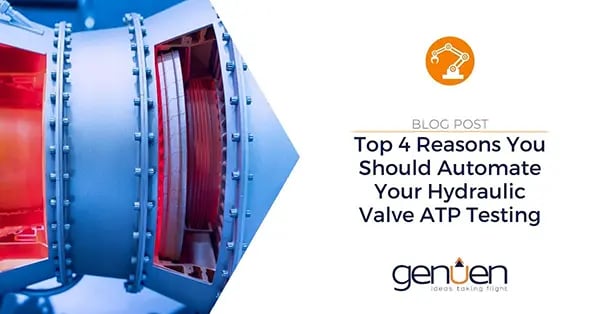What’s the secret to testing more components, reducing your operation costs, and improving your company’s profit margins? Maximizing efficiency. Aircraft manufacturers and MROs have been adopting and implementing operations methodologies to improve their efficiency, such as Lean Manufacturing, for the past half-century. What efficiently ultimately comes down to, however, is operating faster, at a lower cost, and with fewer mistakes.
In more recent decades with the improvement of software and other technologies, automation has become a viable and popular way to improve your company’s efficiency. For aircraft manufacturers and MROs, testing is one important process that can be a good candidate for automation. In this blog post, we’ll be looking at the top benefits of automating your acceptance test procedures (ATP) and two ways you can automate your ATP testing, using aircraft hydraulic valves as an example.

Top Benefits of Automated ATP Testing
Some of the top benefits of automated ATP testing include:
1. Greater integrity of test data
2. Increased testing throughput
3. Improved scalability of test systems
4. Reduced testing operational costs
Acceptance testing is a good candidate for automation, unlike durability, performance, and validation types of testing that tend to be more rigorous and involve more variables. When performing ATP testing, the key is consistency. In order to safely return to service, an aircraft hydraulic valve must undergo the same ATP tests every time and the data must be presented in a standard format. Automation, which only requires initial input from test system operators, is easily repeatable and produces consistent data that is automatically recorded and stored, which is easier to analyze and compare to ATP standards. This data can also be used to analyze variations in component performance over time, which can be used for ATP process improvements.
On an aircraft hydraulic valve test stand, for example, automation is achieved through software programming. Manual operator tasks including adjusting flow, pressure, or temperature can be automated by replacing test system components with others that will respond to prompts from a software program. This can help to reduce or eliminate operator effect/error. Adding transducers that will provide measurement feedback closes the loop, allowing the software to make adjustments automatically based on set parameters. These transducers can also monitor the test part and test system conditions, and trigger an automatic shutdown procedure if a safety hazard is detected, protecting the test operator, component, and system.
If a test setup is more complicated, a manual system may require two operators—one to run and monitor the test system, and one to set up subsequent test parts. Automating ATP testing can help you to increase your testing throughput because it frees up test operators to prepare the next part while another is testing, allowing you to move onto the next ATP faster, or even allowing you to operate two test systems at once. This requires fewer test operators, overall, which can help you save time and money on labor, keeping your team lean. With minimal operator involvement, automated testing requires less skilled labor, again, helping you to reduce labor costs in a competitive market.
Additionally, automation makes your capital equipment investment more scalable by enabling you to add new test parts easily. You simply need to confirm whether the new part operates within the test system’s available range and acquire any necessary mechanical or electrical test adapters, then a programmer can do the rest.
Learn more about acceptance testing procedures for aerospace hydraulic components by downloading our white paper here.
Methods for Automating Your ATP Testing
Two of the primary ways you can automate your ATP testing are:
1. Purchasing a new, automated test system or,
2. Upgrading an existing manual or semi-automatic test system for full automation
You can also, of course, build or upgrade a system in-house. However, we’ll be focusing on outsourcing test system development for this discussion.
Purchase an Automated Test System
Purchasing a test system specifically designed for automation is the easiest and most efficient way to automate your ATP testing. To ensure that the test stand can do what you need it to do, you’ll need to provide a list of all components that you plan to test, and (ideally) documentation including ATPs and part drawings for all parts . The test system manufacturer will then design a system that features components with broad enough ranges to accommodate testing all of your parts. The system will have a data acquisition and control system that will run testing software. A software engineer will create a test script based on each ATP you provide that includes test automation logic.
While purchasing an automated test system requires a greater up-front investment than a manual system (which is often balanced by savings on labor), it is typically more extensible because it allows you to easily add new test parts to your capabilities. As long as new components operate within your test system range, adding new test parts is as simple as getting adapters and programming a new test program, based on the ATP.
Make it work for you: develop your own test script in LabVIEW, Python, or TestStand through our open-source software, or have it developed by Genuen.
Upgrade an Existing Test System with Automation
If purchasing a new test system isn’t in your budget, an alternative is upgrading an existing manual or semi-automatic test stand (which requires some operator input throughout the test). This allows you to preserve and re-use much of your existing system hardware.
An upgrade requires analysis of the existing test system, either through a detailed analysis of system drawings and schematics or through a comprehensive physical inspection of the system, to determine which system components will need to be replaced and where transducers need to be added to enable automation. An upgrade of a manual test system will require a larger overhaul than an upgrade of a semi-automatic system
Again, this will require you to provide a list of all your test components and documentation to develop the test programs. Automation of a manual system will also require a data acquisition and control system, which will house and run the test programs.
Automate Your Hydraulic Valve Testing with Genuen
While automated testing requires a greater up-front investment than manual testing, automation has significant benefits to your business and to your personnel. Regardless of the method you choose to automate your ATP testing, you will improve your testing throughput, reduce your labor costs, and accelerate your overall testing efficiency. At Genuen, we can work with you to find the best solution for automating your acceptance testing. Contact one of our engineers to start discussing your current test configuration.




